How To Fish Big Bear Lake | Your Big Bear Lake Fishing Report
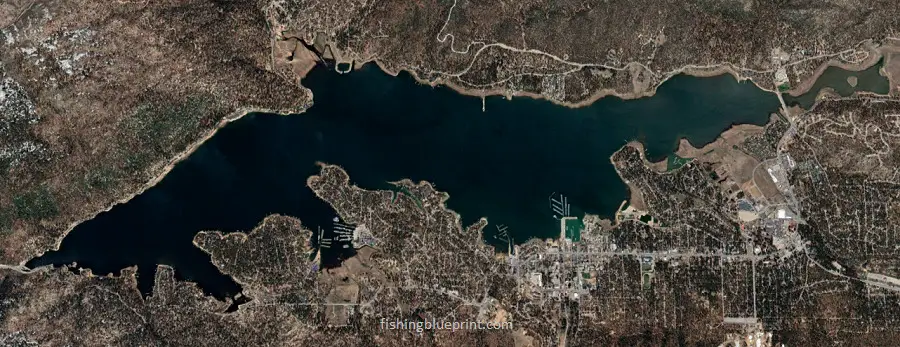
Big Bear Lake is a small lake that sits 97 miles away from downtown Los Angeles and 469 miles away from San Francisco.
Overall this lake is a very popular resort destination year round.. This lake is also featured in countless movies and TV shows due to being so close to Hollywood.
While some visitors are sipping wine and eating expensive cheese at the many local resorts, You can be fishing this lake for its big trout, lunker largemouth and smallmouth bass. And in this post you’re going to be given the blueprint to fish this lake
So what are the best tips for fishing Big Bear Lake? There are three important factors you must know if you want to know how to fish Big Bear Lake successfully. First, you need to know what kind of fish is in Big Bear Lake. Second, it’s important for you to know which part of the lake each species can be found. Lastly, knowing what are the best baits that work on Big Bear Lake is vital. However, tactics, baits, and locations will be different for each type of fish that you target. So let’s talk about the steps you need to take in order to give you the best chance of catching a fish on Big Bear Lake.
About Big Bear Lake
Big Bear Lake is a shallow body of water with the average depth being 30 feet and a maximum depth of 72 feet when the lake is completely full.
Fishing Big Bear Lake can be incredible when you have over 22 miles of shoreline to fish.
Important Lake Warnings
Algae blooms may be present which may affect fishing, swimming, and water contact in general.
According to parks.ca.gov, “every one of California’s new laws requires boat operators to have a California Boating Card. The card is required for anyone under the age of 41 to operate a boat in California’s waters.”
If you are fishing and camping, fire bans may be in effect due to the ongoing drought conditions.
What Kind Of Fish Are In Big Bear Lake
- Rainbow Trout
- Largemouth Bass
- Smallmouth Bass
- White and Black Crappie
- Bluegill and Sunfish
- Perch
- Catfish
Big Bear Lake Fishing Tips & General Strategies
It can be a challenge to break down Big Bear Lake and decide to get started.
But lucky for you, Big Bear Lake is highly regarded as one of the best trout fishing lakes in southern California.
With frequent trout planting efforts, this lake gives anglers a massive opportunity to catch healthy trout.
However, Big Bear also has some great bass fishing. Bass are not as pressured as trout is in this lake and you can catch a good size largemouth in the backs of coves or in vegetation. Smallmouth bass prefer rocky terrain such as steep rocky banks, ledges, and drop offs.
Springtime Fishing update
Water Temperature:
The water temperature can vary depending on the time of day and location on the lake, ranging from the 40s in early spring to 70 degrees Fahrenheit in late spring.
Water Clarity:
The water clarity can also vary, with reports indicating stained or clear water with a visibility of 2-4 feet or more.
Trout Fishing:
For trout fishing, trolling with KastMaster or Thomas Lures Buoyant Spoons and Luhr Jensen Needlefish Spoons (particularly in the frog or bikini color pattern) has been mentioned as an effective technique.
These lures should be trolled slowly at about three colors on a lead core line with a light leader.
Bass Fishing:
Anglers reports the best bass fishing has been on the the North side of the lake between Juniper Point to Standfield Cut Off, where it’s typically warmer. Eagle Point area all the way to the marina is another spot anglers have been catching bass.
You would also check out the coves that have docks. The longer deeper coves have been better than the rest, especially when the water is high enough.
Anglers are also catching smallies and largemouth on the rocky banks and riprap.
Most are using split shot plastics and tubes, flipping creature baits, crankbaits and jerkbaits on the rocky banks, and spinnerbaits or Chatterbaits around the grassy areas.
Based on water clarity and wind, anglers should experiment with different colors and sizes to find what works best.
Big Bear Lake – Summer Fishing update
Hello, fellow anglers! Here’s your summer fishing report for Big Bear! It’s a doozy, so buckle up…
Water Temperature:
The average water temperature during the summer months can range from the mid-60s to low 70s.
Water Clarity:
Water clarity can vary, due to recent storms and wind, but reports say it’s been relatively clear with a visibility of 4+ feet.
Trout Fishing
As with most trout, during the summertime trout prefer the coolest water the lake can provide that is just above the thermocline. And in Big Bear Lake anglers commonly report the thermocline being approximately 30-45 feet deep.
The easiest way to catch these silvery fish is to troll with a downrigger.
If you don’t have a downrigger, that’s okay, your lures should be trolled slowly at around 2-3 colors on a lead core line with a light leader.
Trolling with lures such as small spoons and inline spinners can be effective.
Now if the lake level is low anglers need to concentrate toward the western 2/3 to 1/2 of the lake when trolling for trout.
Shoreline Anglers
The best locations for shore fishing for trout are typically the deeper water areas around the lake’s perimeter.
The bank fishermen, you have a couple of options to fish for trout…
Option 1)
First option is you can use a slip bobber set at around 12 feet deep.
The first thing you need to do is thread on 3-4 small bobber stops (yes, I like to use multiple stops because it prevents it from sliding up and down the line inadvertently). Pull the bobber stops up the line to around twelve feet.
Next, thread on your sliding bobber.
Next, thread on a small 1/16 oz tungsten bullet weight.
Then, tie on a small swivel onto your main line.
Then, using 3-5 feet of 4-pound fluorocarbon line, tie one end to the swivel.
Then, using the free end, tie on a #16 or #18 tiny treble hook.
Then, its time to make a small-size ball of PowerBait and smoosh it around the treble hook.
Important: Since you’re fishing below the bobber, make sure you use only enough to cover the hook, otherwise PowerBait will make the hook float up.
Last, dip the ball of PowerBait into the water. If it sinks you’re in business.
Option 2)
Option two is to make a Carolina rig and float the PowerBait off the bottom.
Using a braided leader line thread on a ¼-ounce tungsten bullet weight and then a swivel.
Then, tie on 3-5 feet of 4-pound fluorocarbon line to the other end of the swivel.
Then, tie on a #16 or #18 tiny treble hook.
Then, make a marble sized ball of PowerBait and smoosh it around the small treble hook.
Last, gently put the rig in the water to test and make sure your hook floats with the PowerBait around it. If it floats, you’re in business.
Bass Fishing:
According to fellow anglers, they suggest using topwater baits early in the morning or late in the evening, as well as fishing with soft plastics or jigs around structure during the day.
When it comes to specific baits, they recommend trying the Strike King KVD Squarebill, Rapala Shad Rap, and Lucky Craft Pointer for reaction-style fishing.
For finesse-style fishing, the Zoom Trick Worm, Roboworm Straight Tail Worm, and Yamamoto Senko are solid choices.
If you’re looking for good locations to catch bass, they suggest trying Boulder Bay, Eagle Point, Metcalf Bay, Stanfield Cutoff, and Grout Bay. These areas are known for their clear water, structure, and depth.
But Where Are The Best Places To Fish At Big Bear Lake?
And in no particular order here is that list of the best fishing spots at Big Bear Lake.
DISCLAIMER: The material provided is for general information purposes only. It’s important to understand that any information provided in this article can change at any time. Any maps or graphics featured are not to be used as navigational aids. Fishing Blueprint will not be responsible for any personal injury or property damage from any misuse of the maps or graphics provided. It’s completely impossible to give you every single spot where you can potentially catch a fish. But, what this list does do is to give you a helping hand and narrow down to the most productive fishing spots.
Big Bear Dam

Fishing just along the dam and in front of Treasure Island can be outstanding if you’re trolling for trout.
If the water is low, graph the cove just to the north of the dam and you can find deep water humps and ledges that rarely get fished.
This section of the lake can get very windy. And even with the best trolling motor the wind can quickly blow you off your spot which will significantly decrease your chances of catching a fish..
That is why we strongly suggest buying a quality drift sock. For those who don’t know, a drift sock is like a parachute for the water. If it’s breezy to windy, you need to slow your drift otherwise your lure will not be in the strike zone long enough to catch a fish.
By the way, we found a really good quality drift sock made by Mythik Outdoors, and best of all they’re sold on Amazon.com. Go here to learn more about drift socks and read the reviews from actual customers.
Located: west lake
Structural features: steep rocky bank
Best species to target: trout, largemouth bass, smallmouth bass, crappie, catfish
Most effective way to fish this spot: boat, kayak, shoreline
Trout Alley
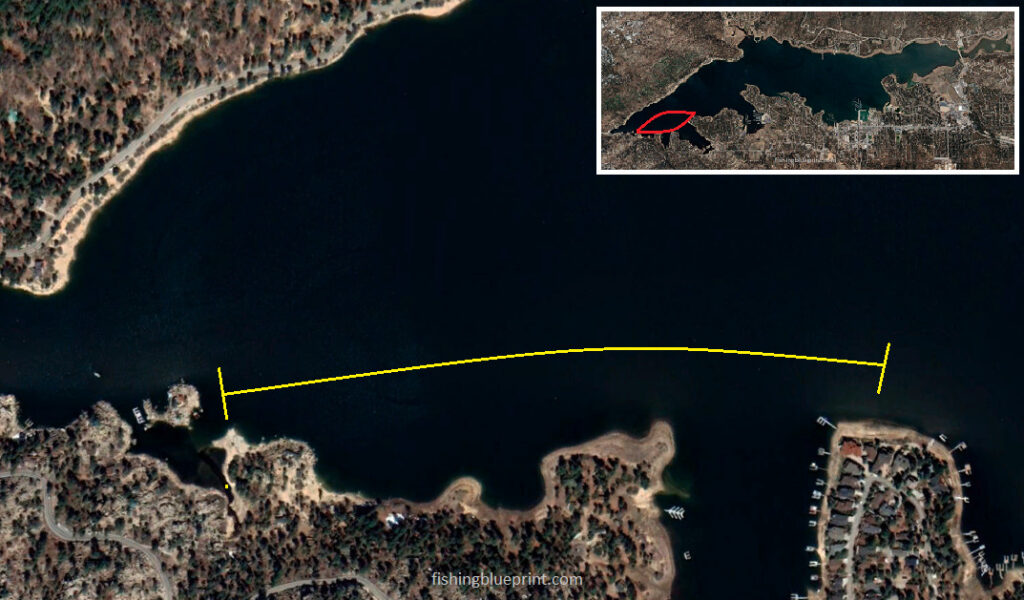
The deep water in front of Papoose Bay, Boulder Bay, and Metcalf Bay is commonly known as ‘trout alley’ and is another great spot to troll for trout.
This area primarily has submerged river channel ledges and steep dropping points.
In the winter and spring this area can be great and trout will hold between 25-30 feet so you can get away trolling without a downrigger.
However, during the summer these fish will be holding deep in 30-45+ feet of water, so trolling with a good downrigger is a must in order to catch them.
Again, make sure you find the thermocline first.
Look closely…

Here’s a screenshot of the topography of the lake. The trout, kokanee, and salmon will often hold over the deep water points and ledges.
Located: middle section of the lake
Structural features: deep water main river channel, natural humps, bars and ridges
Best species to target: trout
Most effective way to fish this spot: boat, kayak
Papoose Bay
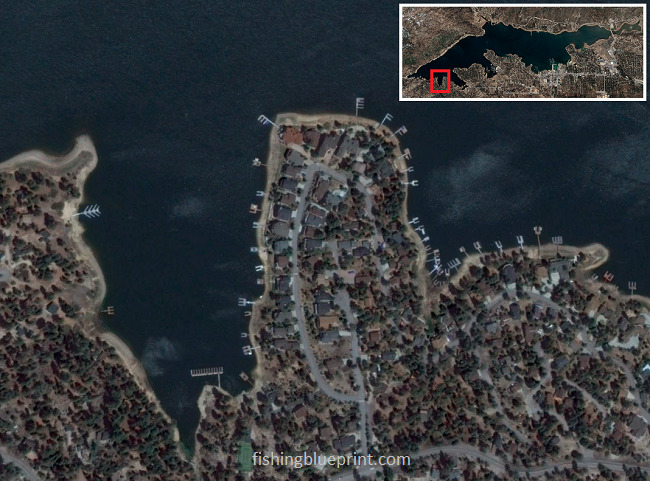
This cove is the smallest among the southern inlets.
A variety of fishing techniques can be employed here to catch different fish species.
The bay’s entrance features deep waters, where trout can be found due to the presence of submerged river channel ledges and sharp drop-off points.
For anglers targeting bass, crappie, catfish, and panfish, the sides and rear of the cove offer large areas with submerged plants, floating vegetation mats (during summer), and rocky banks, ledges, and drop-offs.
Moreover, these fish can also be caught around the lake’s artificial structures, such as docks, breaklines, and seawalls.
The cove boasts a deep channel with grass, which can yield excellent catches from spring through fall. As the weeds thicken, they force the fish deeper into the channel.
The presence of a current also causes baitfish and bass to congregate near the edges, points, and cuts within the weed bed.
In addition, there are several hard spots along the deep channel ledge that attract more bass compared to the surrounding areas.
Located: south lake
Structural features: deep water at the mouth, submerged and emergent vegetation, rocky structure, artificial structure
Best species to target: trout, largemouth bass, smallmouth bass, crappie, catfish
Most effective way to fish this spot: boat, kayak, float tube, shoreline (or off the dock)
Boulder Bay
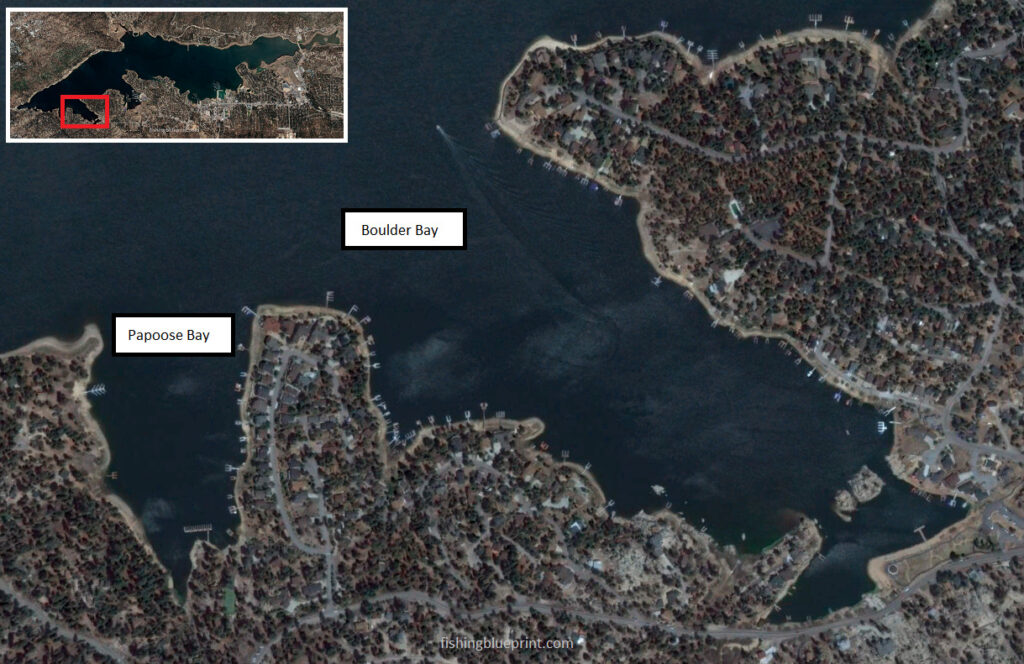
This is a moderate sized cove and can be fished multiple ways for different species of fish.
At the mouth of the bay the deep water can be fished for trout due to its submerged river channel ledges and steep dropping points.
Catfish can be caught in the backs of the bays using cutbait, chicken livers, hotdogs, or premade stinkbait.
Sunfish/panfish can be caught using small trout flies, dough balls, and Slim Jim pieces.
Located: south lake
Structural features: deep water at the mouth, submerged and emergent vegetation, rocky structure, artificial structure
Best species to target: trout, largemouth bass, smallmouth bass, crappie, catfish
Most effective way to fish this spot: boat, kayak, float tube, shoreline (or off the dock)
Metcalf Bay
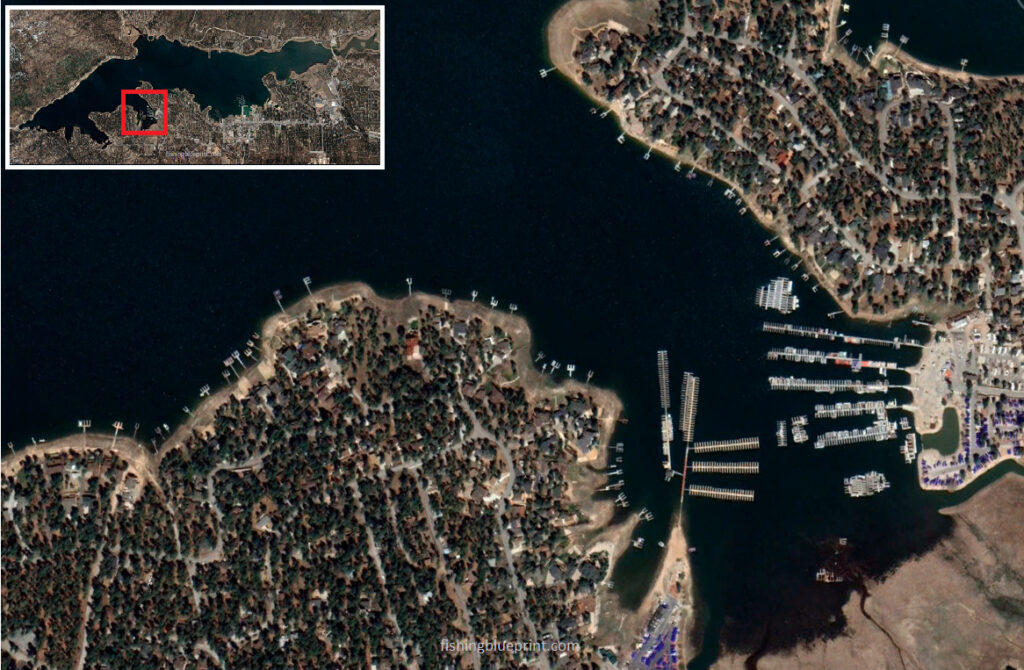
This large area can be fished multiple ways for different species of fish.
At the mouth of the bay the deep water can be fished for trout due to its submerged river channel ledges and steep dropping points.
You can troll for trout along the edges, or you can fish for bass deeper in the pocket.
The bass will commonly hold close to the large boulders (especially in the shadows), on the submerged shelves, or located on the bluff wall-to-bank transitions areas. Looks for transition areas that turn from steep rock wall to boulders, then to chunk rock and pea-gravel.
Located: south lake
Structural features: deep water at the mouth, submerged and emergent vegetation, rocky structure, artificial structure
Best species to target: trout, largemouth bass, smallmouth bass, crappie, catfish
Most effective way to fish this spot: boat, kayak, float tube, shoreline (or off the dock)
Gibraltar Point and Gibraltar Bay

The deep water in front of Gibralter Point extending into Gibraltar Bay is another great spot to troll for trout.
These areas are submerged points, bars, ledges and steep dropping points.
Some of the effective trout baits for this area include: Fish attractor (ie: flasher or a doger), trolling soft plastic swimbaits, spoons, inline spinners, rapala minnows, flat fish, and wedding ring spinners.
Located: middle section of the lake
Structural features: deep water main river channel, natural humps, bars and ridges
Best species to target: trout
Most effective way to fish this spot: boat, kayak, float tube, shoreline (or off the dock)
The Pit & Stanfield Cutoff
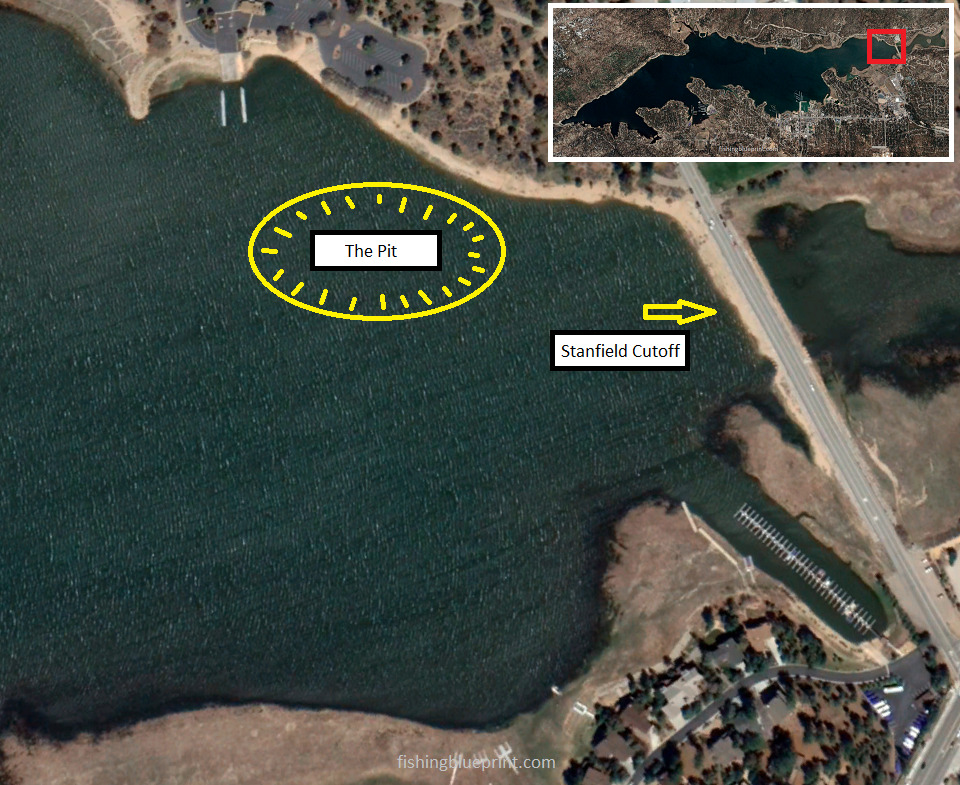
The Pit is a deep area carved into the lake floor to mine clay during the creation of the valley’s dump. Trout like to inhabit this deep water area in the upper section of the lake.
Some of the effective trout baits for this area include:
- Fish attractor (ie: flasher or a dodger)
- Trolling spoons – Krocodile spoon, Super Duper, Crippled Herring, Cast Champ, or Hus-Lure.
- In-line spinners – Bang-Tail, Shyster, or the Blue Fox Classic Vibrax
- Minnow style baits – Luhr-Jensen Quick Fish, Rapala BX minnow, Rapala Original Floating Minnow, Ultra Light Minnow (all are slow sinking)
- Complete done-for-you trout lure kit!
.
Now if you’re fishing from a boat, float tube, kayak, or even from the shore you should also consider using these additional trout baits:
- Real or artificial corn – great because it will never spoil or mold over
- Natural salmon eggs – it’s hard to beat natural salmon eggs when trout are eating them. Sometimes you can go through a couple of jars of these eggs in an hour!
- Artificial salmon eggs – great because they float off the bottom – ideal in rocky or grassy conditions
- Real worms – such as meal worms or nightcrawlers
- Artificial worms – great for trolling and will never die
- Dough bait – great because they stay on the hook really well, it floats if you put enough on the hook, come in a variety of colors and scents.
- Wet flies (sinking flies) – Wet flies imitate insects that develop and inhabit below the water level before emerging and rising to the surface.
- Woolly bugger flies – One of the most popular fly patterns ever is the Woolly Bugger. These mimic small fish, leeches, larvae, and worms.
- Steamer flies – These mimic larger animals found in streams, rivers, and lakes including crawfish, larger leeches, and smaller fish.
.
The Stanfield Cutoff consists of a man made bridge with its banks consisting of chunk rock that attract largemouth and smallmouth bass. Additionally, the area is filled with submerged and floating weedbeds.
To the north is the Carol Morrison East Public Launch Ramp. Boat ramps always have fish nearby. In addition, there is a jetty that has rip rap banks and a fishing pier nearby for shoreline anglers.
Effective baits for bass in this area include: This area can be fished with topwater baits, frogs, buzzbaits, crankbaits, soft plastic swimbaits, spinnerbaits, and underspin jigs when the bass are aggressive.
If the bass are timid, then drop shot, tube, wacky rig senko, Mojo rig, Texas rig, Ned rig, Neko rig, Mojo rig, and football jigs all work really well.
Located: northwest side
Structural features: deep water man made pit, jetties, boat ramp, shallow water submerged and emergent vegetation
Best species to target: trout, largemouth bass, smallmouth bass, crappie, catfish
Most effective way to fish this spot: boat
Observatory Point
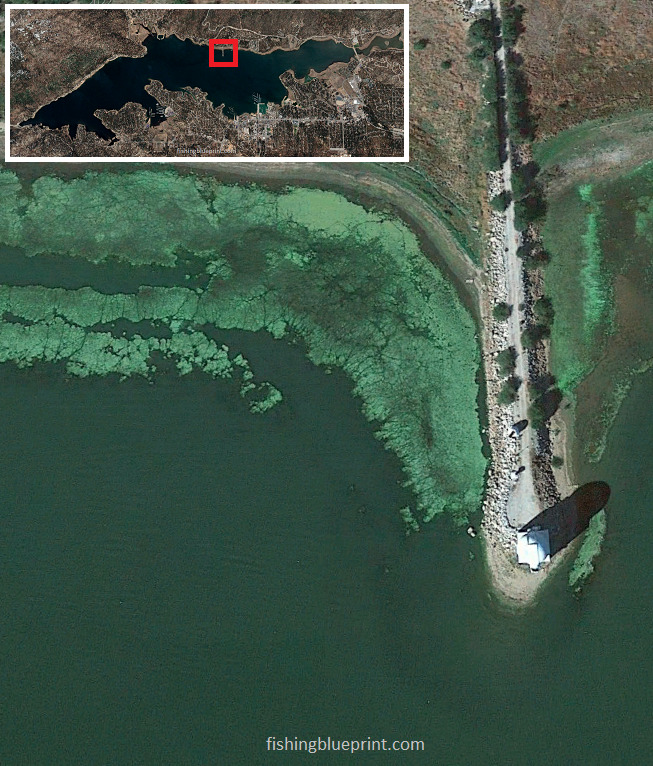
Observatory Point features a long rocky bank that extends out with the point. The bank is characteristically very steep and made from large chunk rock to boulder-size substrate.
The picture above is shown with low water level to show you the large size boulders the local fish call home.
Naturally, crawfish, bluegill, minnows, and shad seek shelter in this area.
Given this embankment’s large area, it’s best to focus your efforts on cuts, points, boulder piles, and transition areas from larger rock to smaller rock size.
Located: middle section of the lake
Structural features: long rocky bank
Best species to target: trout, largemouth bass, smallmouth bass, crappie, catfish
Most effective way to fish this spot: boat, kayak, float tube, shoreline (or off the dock)
Grout Bay
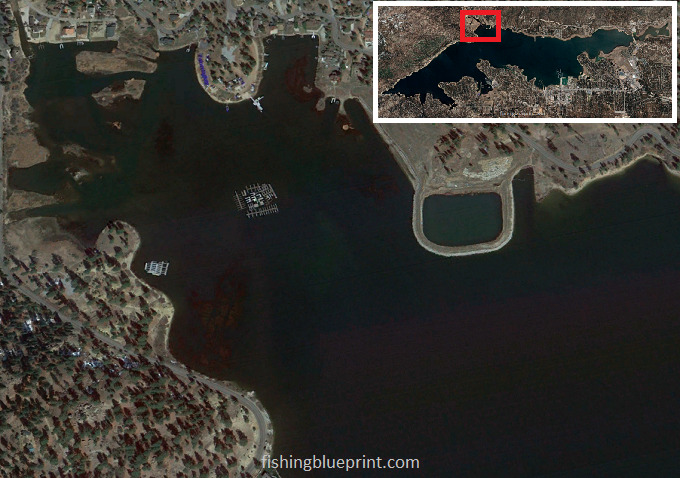
This large area can be fished multiple ways for different species of fish.
At the mouth of the bay the deep water can be fished for trout due to its submerged river channel ledges and steep dropping points.
Trolling for trout is very common in this area.
Some of the effective baits for trout and kokanee this area include: fish attractor (ie: flasher or dodger), trolling spoons, inline spinners, Rapala minnows, Quick Fish, streamers and flies. Better yet, just buy a complete done-for-you trout lure kit!
You have several ways to catch bass, crappie, catfish and panfish anglers.
The main creek channels that drain from the bay to the main lake create underwater main lake points. Scan these areas because they will often have rocky high spots, ridges, humps, and ledges associated with them.
Moving further into the bay, make sure to scan the ditch and channel interactions. This area also has rocky high spots, ridges, humps, and ledges, along with channel swings that can hold fish.
the sides and back of the cove contain large sections with submerged vegetation, floating vegetation mats (during the summer) and rocky banks, ledges and drop offs.
Furthermore, these fish can be caught by targeting this lake’s artificial structures such as: docks, breaklines, and seawalls.
Catfish can be caught in the backs of the bays using cutbait, chicken livers, hotdogs, or premade stinkbait.
Sunfish/panfish can be caught using small trout flies, dough balls, and Slim Jim pieces.
Located: south lake
Structural features: deep water at the mouth, submerged and emergent vegetation, rocky structure, artificial structure
Best species to target: trout, largemouth bass, smallmouth bass, crappie, catfish
Most effective way to fish this spot: boat, kayak, float tube, shoreline (or off the dock)
Windy Point to Grays Landing
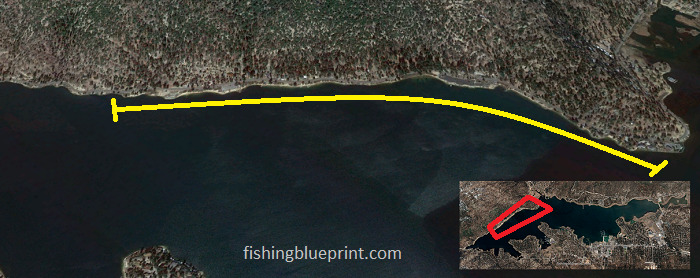
The deep water in front that starts from Windy Point and extends to Grays Landing is a great spot to fish for trout.
These areas are submerged points, bars, ledges and steep dropping points.
Located: middle section of the lake
Structural features: deep water main river channel, natural humps, bars and ridges
Best species to target: trout
Most effective way to fish this spot: boat, kayak
Boat Ramps at Big Bear Lake
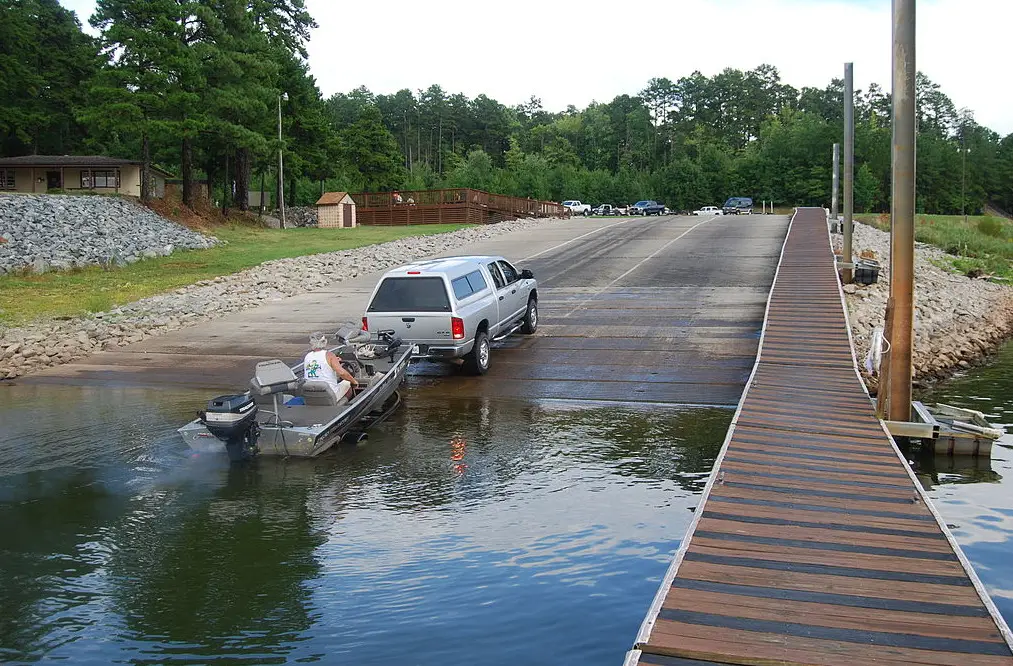
Luckily there are a couple to launch your boat. Here they are…
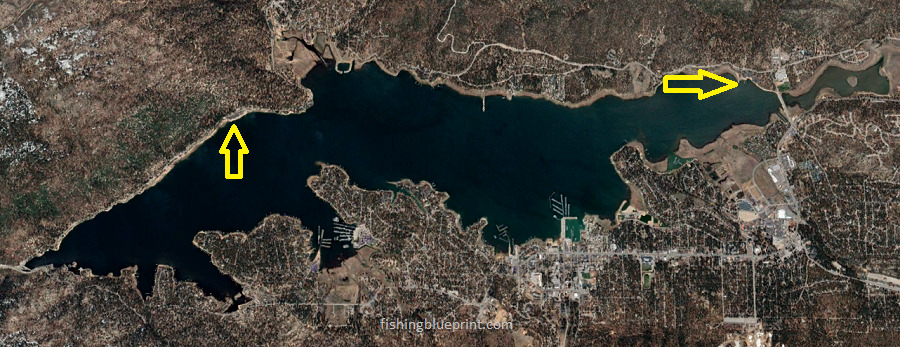
Duane Boyer West Public Launch Ramp
38925 N Shore Dr, Fawnskin, CA 92333
(909) 866-2917
Lanes: 2
Restrooms: Yes
Showers: no
Gas: no
Tackle, groceries, snacks available: no
Fish Cleaning Station: Yes
Camping nearby: Yes
Carol Morrison East Public Launch Ramp
41911 N Shore Dr, Big Bear, CA 92314
bbmwd.com
(909) 866-5200
(909) 866-2917
Lanes: 2
Restrooms: Yes
Showers: no
Gas: no
Tackle, groceries, snacks available: no
Fish Cleaning Station: Yes
Camping nearby: Yes
Marinas at Big Bear Lake

Pleasure Point Marina
603 Landlock Landing, Big Bear Lake, CA 92315
pleasurepointmarina.net
(909) 866-2455
Nearby boat ramp: Yes
Restrooms: Yes
Showers: no
Gas: Yes
Groceries/snacks available: Yes
Electric: No
Camping nearby: Yes
Holloway’s Marina & RV Park
398 Edgemoor Rd, Big Bear Lake, CA 92315
bigbearhollowaysmarina.com
(909) 866-5706
Nearby boat ramp: Yes
Restrooms: Yes
Showers: no
Gas: Yes
Groceries/snacks available: Yes
Electric: No
Camping nearby: Yes
Captain John’s Fawn Harbor & Marina
39369 N Shore Dr, Fawnskin, CA 92333
fawnharbor.com
(909) 866-6478
Nearby boat ramp: Yes
Restrooms: Yes
Showers: no
Gas: Yes
Groceries/snacks available: Yes
Electric: No
Camping nearby: Yes
Lighthouse Trailer Resort & Marina
40545 N Shore Ln, Big Bear, CA 92314
bigbearlighthouseresort.com
(909) 866-9464
Nearby boat ramp: Yes
Restrooms: Yes
Showers: no
Gas: Yes
Groceries/snacks available: Yes
Electric: No
Camping nearby: Yes
Big Bear Marina
500 Paine Ct, Big Bear Lake, CA 92315
bigbearmarina.com
(909) 866-3218
Nearby boat ramp: Yes
Restrooms: Yes
Showers: no
Gas: Yes
Groceries/snacks available: Yes
Electric: No
Camping nearby: Yes
Pine Knot Marina
439 Pine Knot Ave, Big Bear Lake, CA 92315
pineknotmarina.com
(909) 633-7511
Nearby boat ramp: Yes
Restrooms: Yes
Showers: no
Gas: Yes
Groceries/snacks available: Yes
Electric: No
Camping nearby: Yes
Camping Near Big Bear Lake
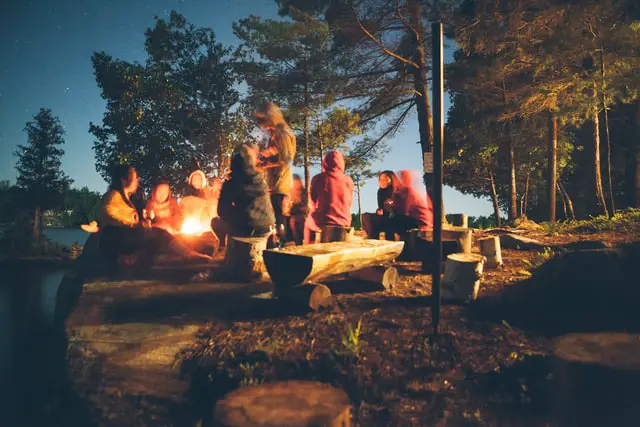
Big Bear Lake is blessed with an abundant amount of campgrounds that cater to RVer’s and standard tent campers.
Most campgrounds offer visitors level parking, picnic tables and fire pits. The majority have bear-proof food lockers. Drinking water and flush toilets are provided.
Fortunately, most campgrounds are pet friendly, but you must keep your fur-buddy on a leash at all times.
Here is a list of both RV/tent campgrounds and boat-in campgrounds.
RV/Tent Campgrounds
Serrano Campground – Map & Reservations
Hanna Flat Campground – Map & Reservations
Horse Springs Campground – Map & Reservations
Big Pine Flat Campground – Map & Reservations
Bluff Mesa Group Campground – Map & Reservations
Boulder Group Campground – Map & Reservations
Buttercup Group Campground – Map & Reservations
Deer Group Campground – Map & Reservations
Grays Peak Group Campground – Map & Reservations
Green Spot Equestrian Group Campground – Map & Reservations
Ironwood Group Campground – Map & Reservations
Tanglewood Group Campground – Map & Reservations
In Summary...
As you now can see Big Bear Lake fishing can be tough at times, but it’s not impossible and with the help of the Big Bear Lake Fishing Report… It definitely helps you get started on the right foot quickly and easily, so you can avoid wasting hours wondering where and how to get started.
Did You Get All This?
As fellow fisherman and content creator I thrive on helping others… I feel like I can do the most good by helping others… And frankly… I would feel like I did something wrong if you didn’t walk away feeling a little better about this lake.
I truly want to over deliver for you…
So Let Me Ask You Another Question…
After reading this helpful report:
- Can you see how this could change the way you would fish this lake?… To make it easier, faster… and… with less headache, less frustration?
- If nothing else, do you now have a better sense of where you can get started, even if you have have been here?
- Do you feel that you have a good grasp of what species to expect in this lake?
- Do you have a good understanding what baits are needed to catch each of the different species of fish?
- Earlier we came up with some helpful spots to catch more fish, can you see yourself considering any one of those spots? Which ones are you the most excited about implementing when you get to the lake?
- Is it fair to say that using these spots would give you a significant advantage over someone else who’s fishing this lake?
I Need To Ask A Favor From You And It’s Not Going To Cost You A Single Dime…
If you have gotten anything out of this free report; whether its knowing where to get started, what kinds of fish are in Big Bear Lake, what baits to use, where to launch your boat, where to buy a frosty beverage, where to camp, and other things to do when you’re at this lake…
Then I need you to do something that is going to help you your fellow angler…
And that is share this report. Please share it to as many people as you can. It’s free to you and it really helps me out as a creator.
Lastly… thank you for spending your time reading through this report and I hope you have a luck on the water.
THIS IS WHERE YOU CAN HELP ME THE MOST: There’s a lot of information about this subject you have found helpful, and I’m sure you’ll be able to put some of the knowledge bombs to use. But sharing this report helps drive traffic which in turn helps me at absolutely no cost to you. I love creating reports like this for you, and you like reading these types of reports please share this with your friends, family, and fellow anglers.
Click on your favorite social media buttons to share this page now!
Other California Related Fishing Articles
- Bass Lake Fishing Report
- Clear Lake Fishing Report
- Castaic Lake Fishing Report
- California Delta Fishing Report
- Diamond Valley Lake Fishing Report
- Don Pedro Reservoir Fishing Report
- Eagle Lake Fishing Report
- El Capitan Reservoir Fishing Report
- Lake Berryessa Fishing Report
- Big Bear Lake Fishing Report
- Folsom Lake Fishing Report
- Irvine Lake Fishing Report
- Lake Almanor Fishing Report
- Lake Camanche Fishing Report
- Lake Isabella Fishing Report
- Lake Havasu Fishing Report
- Lake McClure Fishing Report
- Lake Oroville Fishing Report
- Lake Perris Fishing Report
- Lake Piru Fishing Report
- Lake Skinner Fishing Report
- Lake Tahoe Fishing Report
- Los Banos Reservoir Fishing Report
- New Hogan Lake Fishing Report
- New Melones Lake Fishing Report
- O’Neill Forebay Fishing Report
- Pardee Lake Fishing Report
- Pyramid Lake Fishing Report
- San Luis Reservoir Fishing Report
- San Vicente Reservoir Fishing Report
- Shasta Lake Fishing Report
- Silverwood Lake Fishing Report
- Trinity Lake Fishing Report
- Whiskeytown Lake Fishing Report
More articles just for you...
Funny Fishing Rules, Laws, and Regulations 2025
Crazy Fishing Laws That Will Blow Your Mind! #7 is INSANE! Strange Fishing Regulations and Laws As silly as hook and rod limits may seem,
EXPOSED! How To Use A Spinnerbait The Right Way for 2025
Are You Wondering How To Use A Spinnerbait? Or How To Work A Spinnerbait Over Grass, Logs, or Points? Well, All These Questions Are Answered
EXPOSED! Best Crankbait Colors for 2025 [Which to Buy & Avoid]
What color crankbait to use? Crankbait Color Chart I just love going into a Bass Pro Shops store and just staring at all the walls
Best Underwater Dock Lights For Fishing – 2025 Buyers Guide
Night Dock Light Fishing For Beginners Dear fellow angler, Does this sound like you? You’re someone who loves fishing but just wants to escape the
15 Best Deep Diving Crankbaits [2025 Buyers Guide – Which to Buy & Avoid]
A Complete Buyer’s Blueprint On The Best Deep Diving Crankbaits for Bass, Walleye, or Striped Bass On The Market Today Fishing deep diving crankbaits can

